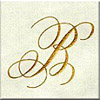The following is a reprint of a Milwaukee Sentinel article from December 24, 1979. It is based on an interview with Ralph Birr. Much of the information is still true today.
"Products of Felix Birr Engraving help dress up corporate images"
By Larry Engel

Ralph Birr checking a set-up.
Helping people make a good impression is what the Felix Birr Engraving Co, Inc. has been doing for 72 (now over 100) years.
Fine engraved stationery and business cards manufactured by the small Milwaukee firm are used by some of the largest and prestigious industrial, business, law, accounting, investment and other organizations in Wisconsin.
"That's one thing that's nice about this business - you're dealing with a lot of nice people," said Ralph C. Birr, president of the firm founded by his father in 1907.
It's a good feeling to know that your products are helping the image of Wisconsin companies and their employees in some important places around the nation and the world, he added.
The firm's custom engraving includes letterheads, envelopes, business cards, invitations and announcements.
Engraving for social purposes-personal greeting cards, stationery, calling cards and invitations-once accounted for most of the firm's sales
Now, it's about 10% of sales. Business, corporate, professional and institutional stationery account for the rest.
Felix Birr Engraving is one of only three (now two) firms of its kind in the Milwaukee area. Once there were at least six.
"Most engraving firms were started around the turn of the century when social etiquette was a little more widely practiced than it is now, and engraving was considered probably the most formal way of leaving a calling cards or writing a note." Birr explained.
Birr's grandparents emigrated from Germany about 1880 and opened a jewelry store in Milwaukee.
"My father as a young boy hated the chore of dusting and winding all the clocks in his parent's jewelry store on Lisbon Ave.," Birr said. "His mother, seeing he had no interest in becoming a watchmaker, obtained a position for him as an apprentice with a Chicago stationery firm."
Felix Birr was 23 years old when he returned from Chicago in 1907 and started his own business in a building on N. Broadway, about where the Milwaukee Athletic Club now stands.
At first, he used his engraving skill to hand cut designs, pictures and lettering into flat metal plates for use by other firms. Later, he purchased stamping equipment to produce engraved stationery and moved his business to the Manufacturer's Home Building at 104 E. Mason St.
After World War I, engraved Christmas cards became popular and Felix Birr Engraving, in addition to its other business, manufactured a line of cards that was marketed through stores and print shops in several states. The company later produced wedding invitations and social stationery for sale through the same outlets.
The demise of that business came when the depression of the 1930's put the cost of such engraved products beyond the reach of the general public.
After the depression, Felix Birr devoted his attention to getting business primarily from industrial, business and professional firms.
Ralph Birr remembers being "unsure if this was to be my future" when he joined his father in the engraving business in 1948 after having been graduated from Lawrence College.
However, his interest grew and he suddenly found himself in charge when his father suffered a fatal heart attack while on his way to work on Jan. 25, 1952.
He noted that although sales fell for a time after his father's death, they have been climbing, particularly since the acquisition of the Bunde & Upmeyer Co. in 1959. "Last year we did seven times the sales we did in 1952," Birr said.
Bunde & Upmeyer had been located in the Plankington Building, 121 W. Wisconsin Ave., where it also had been in the jewelry business for many years.
Bunde & Upmeyer Engraving is operated at 104 E. Mason as a division of Felix Birr Engraving.
Engraving operations didn't change much between the 1920's and the 1960's, Birr explained. All work was hand-fed and stamped with varnish-based inks, and then each piece of stationery was laid out on racks to dry overnight, he said.
Today, the company uses automatically fed, high speed stamping presses and plastic-based inks that dry in minutes.
The firm purchased its first new automatic stamping press in 1962. It now has two high speed presses which can do color register work on a variety of stationery and cards. There is still some hand work because of the technical factors involved in some jobs.
The company will take any order of 100 pieces or more. "The biggest order I ever had in here was half a million impressions for the JI Case Co. in 1959," Birr recalled.
There is a limited market for custom engraving work because of the price, he observed, adding, "It's like the Cadillac of the graphic arts."
Quality probably is a more important consideration than price for the buyers of fine engraved stationery and cards. They want something that is impressive. "I think it's more a matter of executing the work in a proper manner," Birr said. "That is more critical in our business than the price."
He does not expect the demand for engraved stationery to disappear. "I think there will always be a need for this kind of product because it's the kind of product for somebody who can appreciate and wants to use the finer things," he said.


